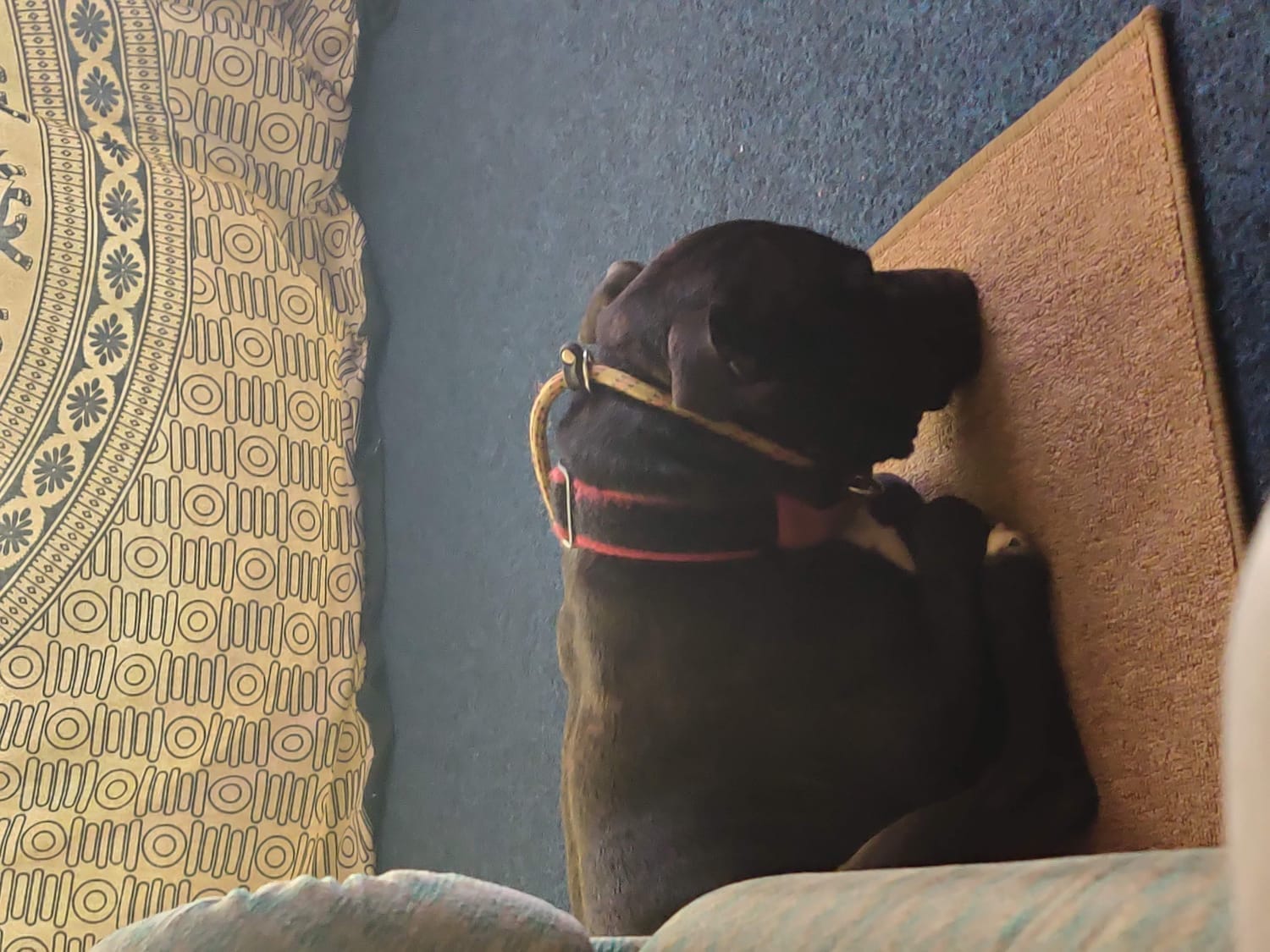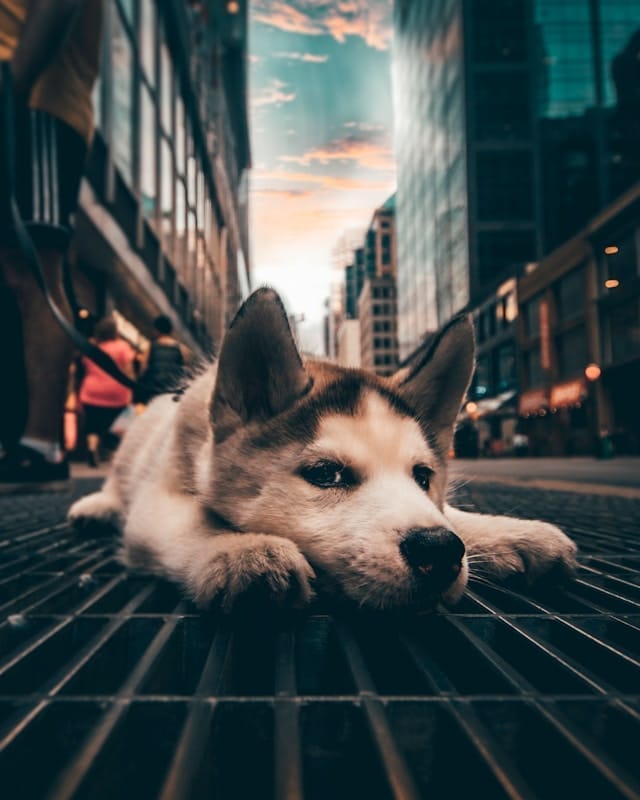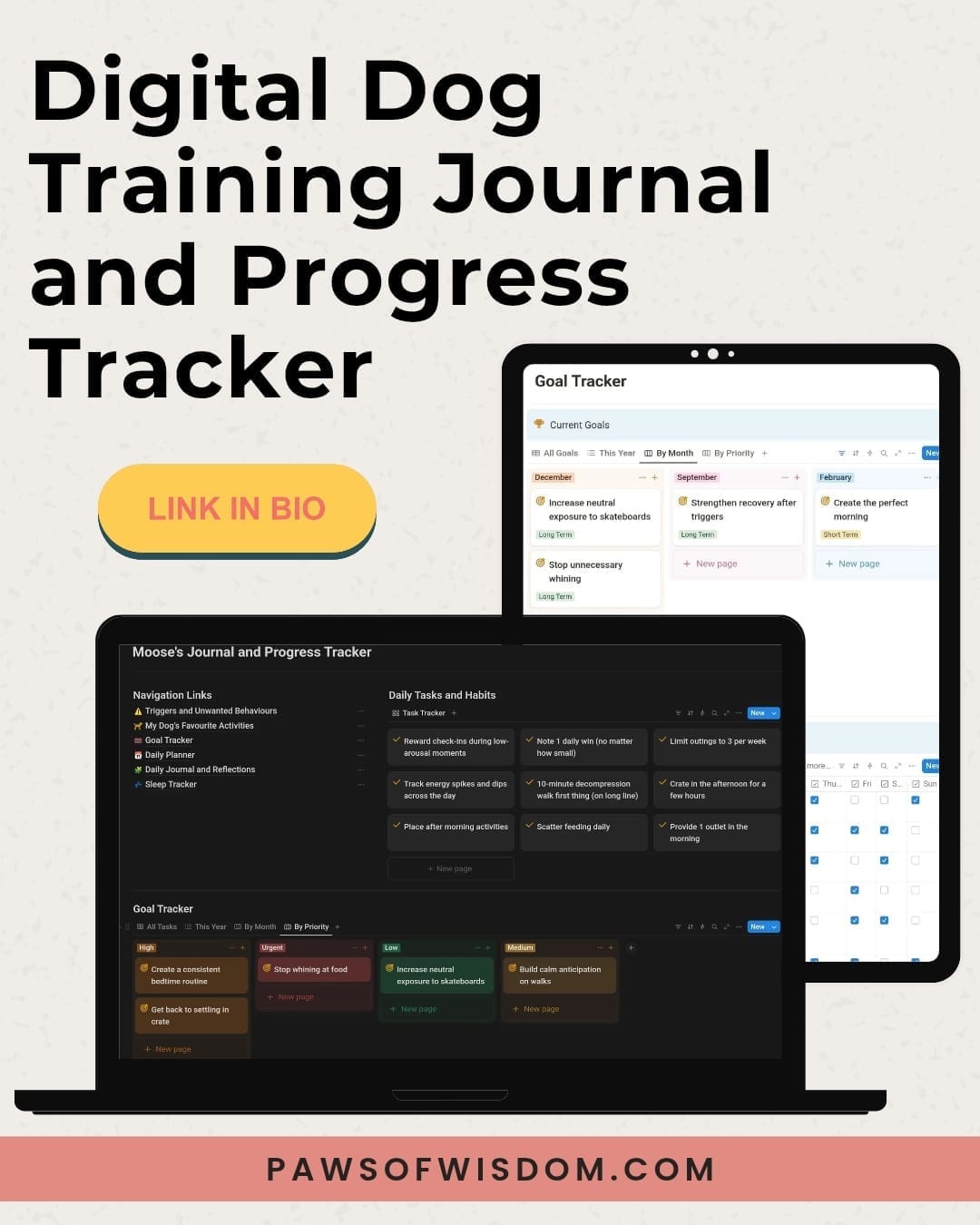Place Training For Dysregulated Dogs: Teaching A Calm, Reliable Settle Anywhere
Place training for dysregulated dogs (and dogs in general) can be one of the most powerful tools in your toolbox, even more so if you’re working with reactivity, anxiety, or chronic overstimulation.
When used well, it builds calm. It helps your dog settle. It teaches neutrality around triggers and creates space for regulation to actually happen.
But when it’s rushed, misused, or taught too early in the process, it can backfire. And instead of building safety and regulation, it adds more stress and frustration into the mix.
In this post, I’ll show you how to use place training in a way that supports your dog's regulation. I’ll also walk you through how I used it with Jasper, and why this single tool helped us reset and build the much needed structure when everything else felt like it was falling apart.

This post contains affiliate links. I only recommend products I’ve used and believe in. Any commission goes toward the improvement of Paws of Wisdom and the occasional treat for Jasper 🐾
Why Place Training Works for Dysregulated Dogs
Place training becomes more than just a command for dysregulated dogs...it becomes a pattern.
A known location. A signal to your dog that it’s time to settle, regulate, and find calm again.
Dogs thrive on structure and predictability. They feel safer when they know what to expect and what is also expected of them. That’s exactly what the place command provides. With enough consistency, it becomes a structured zone that cues the nervous system to slow down. Over time, that spot becomes a space for regulation.
They know what it means. They know the rules. And when something becomes familiar like that, there’s less space for overarousal, frantic pacing, or stress to take over.
For dogs who struggle with anxiety, reactivity, or chronic overstimulation, this tool can be a game-changer. Because it’s not just a behaviour you’re teaching...
It’s a habit you're building.
It's a daily moment of stillness they can return to, again and again.
It's a lifestyle.
Peep below at Jasper contemplating his life choices whilst on place

Place training teaches your dog to go to a specific spot (like a mat, bed, or platform) and stay there until released.
While it’s technically a ‘stay’ with boundaries, the real power comes from creating a predictable, structured zone where your dog can learn to relax and regulate.
Benefits of Place Training For Dysregulated Dogs
#1 - Promotes Calmness
When sending a dog to a “place”, you encourage them to settle down regardless of what is going on around them. This isn’t something that happens overnight. It takes time, consistency, and gradual exposure to distractions. But with practice, it becomes a powerful way to help your dog choose calm instead of chaos.
Whether you are having guests over, or if you want to give your house a clean and your dog has a personal vendetta against the hoover, or even if your dog like to bark out the window at every leaf that blows by. It's a multipurpose tool!
#2 - Provides Clear Boundaries
One of the best things about place training is how clear and visual it is. When you ask for a stay, dogs often fidget, move around, or even just get up and sod it all off together. But with place, there’s a defined spot. Your dog doesn’t need to lie down (unless you want/need them to), they just need to stay on that space. That’s why I always suggest using a raised cot, because your dog has to step down. If you use their everyday bed, it can confuse the boundaries. Place is different. You stay there until you’re told otherwise, and the physical space helps make that expectation crystal clear.
#3 - Encourages Independence
If you have a Velcro dog who follows you from room to room, watches your every move, or constantly seeks reassurance, place training can help build independence. Many dogs struggle with being alone or not being the centre of attention for more than 5 seconds. This can feed into anxious behaviours, separation issues, frustration/anticipation, and general insecurity.
By making place part of your routine, you give your dog something to focus on while you go about your day. Instead of shadowing you to the bathroom or hovering during dinner, they learn to settle in their own space.
#4 - Versatility and Generalisation
Once learned, 'place' can be generalised to various environments and scenarios. Whether you're at home, at a friend's house, at the pub, in the car, at the park, on a hike, outside the store, at the vet etc. The possibilities are endless, but even more so, it allows you to bring your dog to places (no pun intended) you wouldn't have thought of taking them in the first place.
With my dog Jasper, I taught him to “place” on a raised cot; then I moved it to a doormat. I took that doormat with us everywhere, which allowed him to chill out with me at the pub and on sunny days out with friends etc. Now he's at a stage where I can point to a surface, ask him to place, and he’ll drop down happily and wait.
#5 - Boosts Confidence
Place training is especially useful for dogs dealing with anxiety or insecurity. Done right, it becomes a safe, positive space. Over time, dogs learn to regulate their emotions and handle challenges that would have overwhelmed them before.
What I love most is that place gives them a job. Instead of reacting to every noise or feeding off the energy of guests, they have a clear task. That focus builds confidence and helps them feel more in control, which leads to a calmer, more balanced dog overall.
Ready to Help Your Dog Feel More Regulated and Calm?
👉🏾 [Grab the Paws Of Wisdom Detox Protocol] and give your dog the reset they need to feel safer, more balanced, and ready for training like place work.
How To Use Place Training In Your Everyday Life
One of the best things about place training for dogs is the versatility. Once your dog understands the concept, you can generalise this to a number of situations which may have normally caused your dog overwhelm and over reactions.
I use this mainly at home with Jasper, but we do make use of it in the “real world”, in situations I never thought he'd be able to handle.
Below are some of the ways you can start integrating place training into your routine:
#1 - Prepping Food
If you have a dog that constantly pesters you when you're making food or one that uses that opportunity to counter surf or preoccupy themselves with mischief around the house, this is for you!
Using “place” while you prep food helps your dog stay calm and out of the way. Throwing a reward every now and then to our dog while they are calm will help them realise that staying on a “place” can be equally as rewarding than causing chaos.
#2 - Having Guests Over
One of the best times to use “place” is when guests come over.
Dogs can get excited, overwhelmed, or even reactive with new people around. Setting up a “place” before your guests arrive not only helps your dog have a job to do, but also and gives them a predictable, structured alternative to over-greeting or barking.
Give them a Kong or chew to settle in, and let guests know this is your dog’s safe space. If your dog does end up calming down and seems like they can handle it, you can release them to say hi later.
#3 - While Cleaning
If you have a dog that has a personal vendetta against the hoover, or a tendency to walk across mopped floors, or you just want them out of the way of cleaning supplies then you can pop them on their "place" while you clean, and you’ll save yourself from re-cleaning whatever chaos they create behind you.
#4 - When You Want to Watch TV/Relax
Some dogs think the second you sit down is the perfect time to beg for attention...
I use “place” in the evenings when I want to relax or watch a film. Jasper knows it’s time to chill, not play or deman attention.
I’ll reward him with calm affection rather than food or toys, but if your dog struggles to settle at first, you can offer a Kong or low-arousal chew to help ease into it, or ensure decompression such as scatter feeding beforehand.
#5 - When Your Dog is Overstimulated
Once you can start understanding the signs of overstimulation, you can always redirect your dog to their 'place' to help them decompress. This provides a safe space for them to calm down and regulate their emotions.
Sometimes, it’s best to first bring arousal down with something like decompression, scentwork, or a gentle massage. Then, once they’re more regulated, guide them to their “place” so they can fully settle and reset.
Used this way, place becomes a decompression tool, not just a command.
#6 - On Hikes and Walks to Make Space
Place training isn’t just for the house. I use it with Jasper out on walks and hikes to create space especially if there are triggers around.
Now, you can carry a mat with you and use that, but if your dog understands the concept, a bench, log, rock, or low wall can all become a “place”.
When on hikes or walks with Jasper, I make use of benches, tables, raised walls, those large boulders etc. He understands the concept of ‘I wait here until you tell me I can come off’.
This helped so much with his reactivity as I could create that distance. When I sense something approaching that might stress Jasper out, I’ll cue him onto a surface and stand in front to advocate if needed. Jasper started being able to trust me more in those situations which actually made walking him in these environments a lot easier.
#7 - At Pubs/Cafes
If you want to bring your dog to more social settings, “place” is essential.
These places (no pun intended) can be overwhelming...the people, new smells, other dogs etc. Having a consistent place to settle gives your dog security and structure, so they’re not left figuring it out alone.
Bring a mat or towel, advocate for your dog (no random petting), and give them time to relax in that space. With practice, it becomes second nature.

How To Start Place Training With Your Dog: A Step-by-Step Guide
Place training doesn’t need to be complicated, but you do need to build it up in layers. Like anything worth doing, it takes consistency, patience, and smart small progression.
Here’s how to get started step-by-step, from introducing “place” all the way to real-world practice:
Step 1: Choose Your "Place"
This can be one of the trickiest parts to decide on (yes choosing the place), especially because technically anything can become a “place.” But I always recommend using something new that isn't a bed your dog already uses.
A raised bed or cot is my go-to. Clear boundaries help dogs understand where their “place” starts and ends, and prevent creeping or sliding off during training. Mats can work too, but in my experience, dogs are more likely to shuffle off "without realising".
Step 2: Introduce the "Place"
Start simple. You can either lure your dog onto the “place” and reward, or try free-shaping if you prefer that route. Either way, you’re marking and rewarding for each step toward the behaviour you want
Once your dog starts to understand what’s expected, add a verbal cue (“place” or whatever you choose) so they can start connecting the word with the action.
To help, I often pair in hand signals or light leash pressure to guide them. Hand signals especially come in handy later when you start generalising the command in new environments.
Step 3: Build Duration
Once your dog is constantly stepping onto their “place” with minimal pressure/help, it's time to start building duration.
Don’t get carried away. Start small with just a few and gradually increase it. A lot of owners make the mistake of being like “my dog knows this” and expect them to hold a place for an unreasonable starting time.
If your dog keeps stepping off or looks confused, it means you’re rushing. Simply lure them back on and reduce the difficulty. Remember you're building a foundation here, so make sure that it's strong.
Step 4: Add Distance
Only when duration is solid, start adding distance. This means putting your dog on “place,” taking a step back, and seeing if they hold it.
This will potentially cause a lot of dogs to slip up, but this allows us to teach them that even if we move, the same rules apply. If this is the case calmly reset them and try again.
Be patient, as this is now a different scenario for the dog and may take a few reps to understand. The key here is to increase your movement gradually: step back, walk around them, leave the room for a second, etc. You want your dog to learn that no matter where you go, their job is to stay put until released.
Different picture, same environment.
Step 5: Introduce Distractions
Once your dog can hold duration and distance, it’s time to up the challenge.
You want to start easy, if your dog loves fetch and goes crazy at the sight of a ball make sure you avoid starting with that as your first distraction.
Remember we want to set our dogs up for success rather than failure. Think things such as movement (which they should be getting used to due to distance training), toys, dropping food, getting down to their level (but not actually releasing them).
We want to set up our dogs for success but we do want to also test them, let them understand that regardless of what goes on if they aren't released they must stay where they are.
Using higher value rewards may help a lot more here, you can't expect your dog to hold a “place” when the reward is kibble and you've dropped shredded chicken on the floor!
Step 6: Generalise to Other Surfaces
Now that your dog understands the behaviour, it’s time to make it flexible.
As mentioned earlier, I like pointing to the “place” when I teach it. Dogs are great at following human gestures, so if I point to another surface and ask for a place, I want them to follow the gesture and go to said "place".
Practise this around the house, in different rooms, and in different setups. This helps your dog understand that “place” is about the behaviour, not the bed itself.
And remember: if your dog struggles, break it down. Lure them back, simplify, and reward the wins.
Step 7: Practice in Different Environments
For this step, don't take your dog to the pub straight away and try to practice this. You want to take them somewhere that is a low distraction that you can build up upon. A great starting point is your back garden. Or out in your drive. Or if you have neither then take to a quiet area somewhere such as a quiet area in your neighbourhood.
Once they start doing well in these less distracting environments, start adding duration, distance and distraction again so that you can paint the same picture you did indoors for your dog.
Once they start getting the hang of this, start to take this to different and slightly more challenging areas but make sure you are going at your dogs pace! Don't rush this otherwise you will find yourself coming back to the foundation steps!
💡 Track the Calm Before the Calm
Place training works best when you understand what’s fuelling your dog’s energy. Try journaling the build-up of their day before each session. Make a note of walks, meals, triggers, naps, and anything that might impact their ability to settle. Over time, you’ll spot patterns and know exactly how to set them up for success.
👉🏾 [Check out my Digital Dog Training Journal] — your all-in-one tool to record progress, spot trends, and fine-tune your training.
The Dangers Of Anticipation and Frustration
Anticipation usually happens when dogs start to predict patterns. If you always use “place” before walks, mealtimes, or guests arriving, your dog might start pre-empting the command. Now this can be a good thing in some cases, but at times it’s the opposite.
Dysregulated dogs especially can learn the wrong patterns. Instead of learning that “place” means calm, they associate it with excitement or chaos, and rush to the mat out of habit or pressure, not relaxation. If they’re always rewarded immediately, they might start bouncing on and off for treats too.
It can also happen when dogs aren’t totally clear on when they’re released. If there’s no clear cue, they might fidget or guess, which leads to more anticipation and less actual regulation.
How To Reduce Anticipation On Place
To reduce anticipation, shake up your routine. Ask for “place” at unexpected times and mix up how long your dog stays there. Sometimes reward early, sometimes delay it. Slowly reduce reinforcement rate (or as I say "stretch it out").
Clarity is key. Always use a clear release cue like “free” so your dog learns they stay until told otherwise. If they get up early, calmly guide them back without fuss. This isn't punishing, just resetting.
Most importantly, reward calmness, not chaos. If your dog flies onto the mat with excitement, pause a moment before rewarding. Wait for a breath, a sigh, and then mark and reward. This teaches that “place” is a calm, collected space, not a frantic game.
Key Tips…
Keep training sessions short and positive, always ending on a successful note (if possible).
Use high-value treats to motivate your dog when you are working in more distracting environments. Kibble won't cut it for some scenarios!
Make sure you are meeting your dog's needs, you can't expect a dog to settle on “place” if they are filled with energy or constantly overstimulated.
Be patient and consistent. Every dog learns at their own pace and if they really are struggling break down the steps into smaller steps!
Set your dog up for success!
Avoid using the “place” as punishment or even time out in the beginning!
Don’t skip or rush distraction and duration! Many people forget to proof behaviours and then wonder why their dog can’t perform in new environments.
Final Thoughts
As you can see, place training for dogs isn't just a command, it's a lifestyle!
I don’t know where we’d be without place training. It’s been one of the most valuable skills in helping Jasper cope with the world but because it gave him structure, safety, and space when he needed it most.
It’s one of those things that feels so simple, but it’s made a massive difference to how we live our lives. I’ve used it in situations I never imagined we’d manage and over time, it became more than just a command.
It became a way for him to feel more secure and for me to feel more confident in what I was asking of him.
If you’re working through reactivity, anxiety, or even just struggling to create calm in your home then give it a real shot. Build it into your day, proof it in real life, and watch how much changes when your dog has a place to land.
Frequently Asked Questions (FAQs): Place Training Q&A
“Stay” is about waiting to be released, which can frustrate anxious or impulsive dogs. “Place” gives a defined zone, helping them relax and regulate.
It varies. Some dogs pick it up fast, others need more time. Success depends on consistency, timing, and meeting your dog’s needs.
As long as they’re trained and comfortable. Start short, build gradually. Meet their needs first if aiming for longer durations.
They’re likely not ready yet. Take a step back in training, reduce distractions, and make sure they’re not full of excess energy.
It promotes calmness, decompression, and helps dogs feel safe in new or stressful environments, and especially valuable for reactive, dysregulated or anxious dogs.
Related Reading
A FREE community with downloadable guides and resources, and people who get it.
A simple and structured reset for overstimulated, dysregulated, chaotic dogs.
Simple, clear guidance to help you understand your dog through a regulation-first lens.










